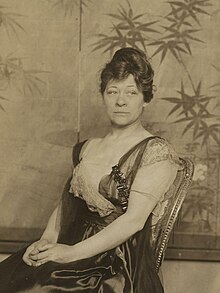Juliana Force
Juliana Force | |
|---|---|
 Force in about 1920 | |
| Born | Juliana Rieser December 25, 1876 |
| Died | August 28, 1948 Manhattan, New York |
| Occupations |
|
| Spouse | Willard Burdette Force |
Juliana Force (December 25, 1876 – August 28, 1948) was the founding director of the Whitney Museum of Art in the United States.[1] During the Great Depression she was the administrator of Region 2 (New York City and State) of the New Deal-era Public Works of Art Project.[2]
Biography[edit]
Force was born to Maxmillian Rieser and Juliana Schmutz in Doylestown, Pennsylvania, on December 25, 1876. Her parents were immigrants from Baden, Germany. [3]: 645
She attended the Northfield Mount Hermon School in 1896 for three semesters, then left to teach English and secretarial courses at a business school in Hoboken.[4] After directing a secretarial school in New York City, she became secretary to Helen Hay Whitney, wife of a prominent financier. In 1912 she married Willard Force. Two years later, when Helen Whitney’s sister-in-law, Gertrude Vanderbilt Whitney, established the Whitney Studio to show the work of young modernist artists, Juliana Force was asked to assist in managing the studio. After the Metropolitan Museum of Art in 1929 rejected Gertrude's personal collection of contemporary works of art, the Whitney Museum of American Art was born in 1930, with Force as director. She remained director of the Whitney Museum until her death.[1]
She died of cancer in Doctors Hospital in Manhattan on August 28, 1948; she was 71.[3]: 646
References[edit]
- ^ a b Berman, Avis (1990). Rebels on Eighth Street : Juliana Force and the Whitney Museum of American Art. Internet Archive. New York: Atheneum. ISBN 978-0-689-12086-2.
- ^ Public Works of Art Project. Report of the Assistant Director of the Treasury to Federal Emergency Relief Administrator, December 8, 1933 – June 30, 1934. Washington, D.C.: Government Printing Office. 1934. pp. 3–4.
- ^ a b Edward James (1971). Notable American Women, 1607–1950: A Biographical Dictionary, volume 1, A–F. Harvard University Press. ISBN 9780674627345.
- ^ "The Force Behind The Whitney". American Heritage. 1907-04-09. Retrieved 2024-03-13.
Further reading[edit]
- Barbara Goldsmith (2011). Little Gloria. Knopf Doubleday Publishing Group. ISBN 9780307800329.
- Anna Indych-López (2009). Muralism Without Walls: Rivera, Orozco, and Siqueiros in the United States, 1927–1940. University of Pittsburgh. ISBN 9780822943846.
- Phyllis J. Read, Bernard L. Witlieb (1992). The Book of Women's Firsts: Breakthrough Achievements of Almost 1,000 American Women. Random House Information Group. ISBN 9780679409755.
- Gerard C. Wertkin (2013). Encyclopedia of American Folk Art. Routledge. ISBN 9781135956141.
- Lindsay Pollock (2007). The Girl with the Gallery: Edith Gregor Halpert and the Making of the Modern Art Market. New York: PublicAffairs. ISBN 9781586485122, page 130.
